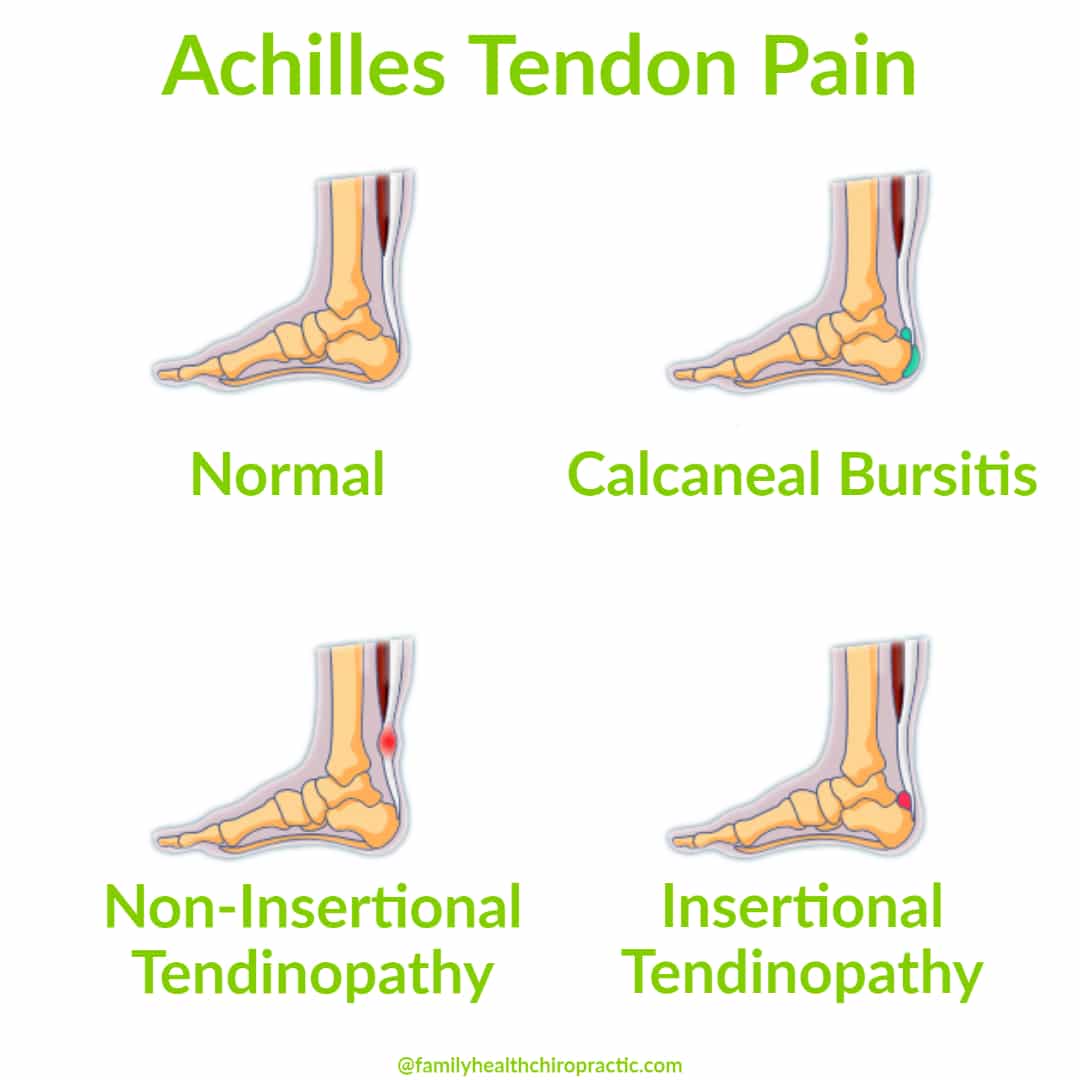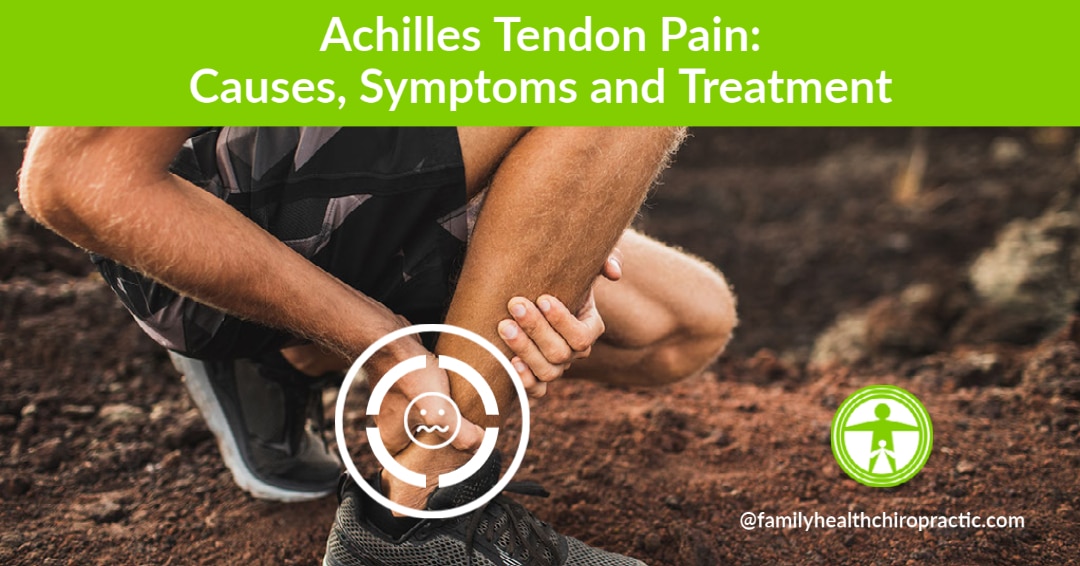Achilles tendon pain occurs from injuries sustained by the Achilles tendon.
The Achilles tendon is the largest and strongest tendon in the body. Located in the back of the heel, the Achilles tendon connects the heel bone to the calf muscle. Named after the Greek god Achilles, it helps you walk, run and jump by raising the heel off the ground. Ultimately, the Achilles tendon influences everyday activities including high performance movements during athletic and recreational play.
Achilles tendon injuries affect between 250,000 and 1 million people per year in the United States. [1] Most are middle-aged males in their third or fourth decade of life. [2] Two-thirds of all Achilles tendon injuries involve athletes and 1 in 20 recreational runners will develop Achilles tendinopathy. [3] Not surprisingly, a higher risk has been identified in other sports that involve running or jumping. The estimated incidence of Achilles tendinopathy is: running sports, 53%; soccer, 11%; dance, 9%; gymnastics, 5%; racquet sports, 2%; football, 1%. [4]
In this article, I'll share the most common causes of Achilles tendon pain and potential treatments to consider.
Causes of Achilles Tendon Pain
The primary causes of Achilles tendon pain include:
- Achilles tendinitis – inflammation of the Achilles tendon itself
- Achilles tendinosis – when the tendon starts to break down due to unresolved tendinitis
- Achilles tendon rupture – when the tendon tears or breaks down
Achilles tendinitis is when a tendon becomes irritated or inflamed. Tendinitis is usually the first sign of an Achilles tendon injury and it’s critical to treat the Achilles tendinitis before it progresses to tendinosis.
There are two types of Achilles tendinitis
- Noninsertional Achilles tendinitis – The fibers in the middle of the tendon start to break down, swell and thicken. This type of Achilles tendinitis affects people who are younger and more active.
- Insertional Achilles tendinitis – This type affects the lower part of the heel, where the tendon connects, or inserts, to the heel bone. It can affect anyone, even people who aren’t active. But it most commonly affects people who overuse the tendon, such as long-distance runners.
Risk factors
A number of factors may increase your risk of Achilles tendinitis, including:
- Your sex. Achilles tendinitis occurs most commonly in men.
- Age. Achilles tendinitis is more common as you age.
- Physical problems. A naturally flat arch in your foot can put more strain on the Achilles tendon. Obesity and tight calf muscles also can increase tendon strain.
- Training choices. Running in worn-out shoes can increase your risk of Achilles tendinitis. Tendon pain occurs more frequently in cold weather than in warm weather, and running on hilly terrain also can predispose you to Achilles injury.
- Medical conditions. People who have psoriasis or high blood pressure are at higher risk of developing Achilles tendinitis.
- Medications. Certain types of antibiotics, called fluoroquinolones, have been associated with higher rates of Achilles tendinitis.
Symptoms of Achilles Tendon Pain
Symptoms of Achilles tendon pain will usually affect the lower leg above the heel.
Patients often experience:
- Heel pain and/or ankle pain
- Stiffness or tenderness in the tendon
- Leg weakness
- Swelling around the Achilles tendon
You may notice more discomfort:
- After you are active or the day after exercising
- As you climb stairs or go uphill
- In the morning, with improvement throughout the day
Complaints include pain or tenderness in the tendon or heel that intensifies with activity, especially walking or running. Patients also report difficulty when attempting to stand on their toes or walking steps- especially when walking down stairs. Morning pain and stiffness are very common.

Mid tendon pain suggests non-insertional tendinitis, whereas posterior calcaneal pain suggests insertional tendinitis. It is also entirely possible that the tendon is healthy and you simply have calcaneal bursitis.
Those with insertional tendinopathy may demonstrate evidence of bony enlargement or spurring on the posterior calcaneus as well.
Treatment for Achilles Tendon Pain
Nonoperative or nonsurgical treatments should always be considered first!
“Traditional” treatments such as rest, therapy modalities, orthotics, and NSAIDs have all failed to demonstrate benefit for Achilles tendinopathy patients. [5]
Passive modalities including ultrasound, electrical stimulation, and low-level laser also lack support. [6][7]
The current standard of care for Achilles tendinopathy includes a combination of rest, eccentric rehabilitation, and correction of mechanical faults.
Studies have demonstrated excellent results in up to 85% of patients undergoing appropriate conservative care. [8]
Initially, you may need to limit or stop activities that are causing “damaging” type pain such as sharp, shooting, burning or tearing pain. Significant strains may also require the use of supports including crutches or a boot. Runners may need to switch to swimming, cycling, or other activities that limit stress to the Achilles tendon and allow it to heal. Patients should avoid shoes with an excessively rigid heel tab to reduce irritation.
Soft tissue manipulation, stretching, and myofascial release techniques are necessary to promote flexibility of the calf muscles as well.
Stretching of the calf muscles should be performed with the knee straight to address the gastrocnemius and with the knee bent to lengthen the soleus.
Achilles Tendon Pain and Chiropractic Care
Achilles tendon pain is common in athletes and active people.
If you have Achilles tendon pain, a Chiropractor can help to diagnose the type of Achilles injury, identify potential causes of your injury and recommend the appropriate treatments.
Your chiropractor will recommend several different types of treatment, including:
Manual Therapy or IASTM
Manual Therapy and Instrument Assisted Soft Tissue Mobilization (IASTM) are extremely effective for breaking up scar tissue and improving issues with soft tissues. Treatment can do a lot to improve the health of your tendon and the surrounding tissues to avoid further complications. It will also do a lot to help relieve the pain you are experiencing.
Chiropractic Adjustments
Many times, the issues with your Achilles tendon are the result of misalignment in other parts of your body. When your joints are misaligned it tends to put extra stress on your feet and Achilles tendons. To minimize the stress on your joints, your chiropractor will adjust your spine and other joints to ensure proper alignment.
Get Help for Your Achilles Tendonitis
If you are experiencing heel pain, please get in touch with our chiropractic team. We can help to alleviate your pain and help you avoid experiencing further problems with your Achilles tendon.



